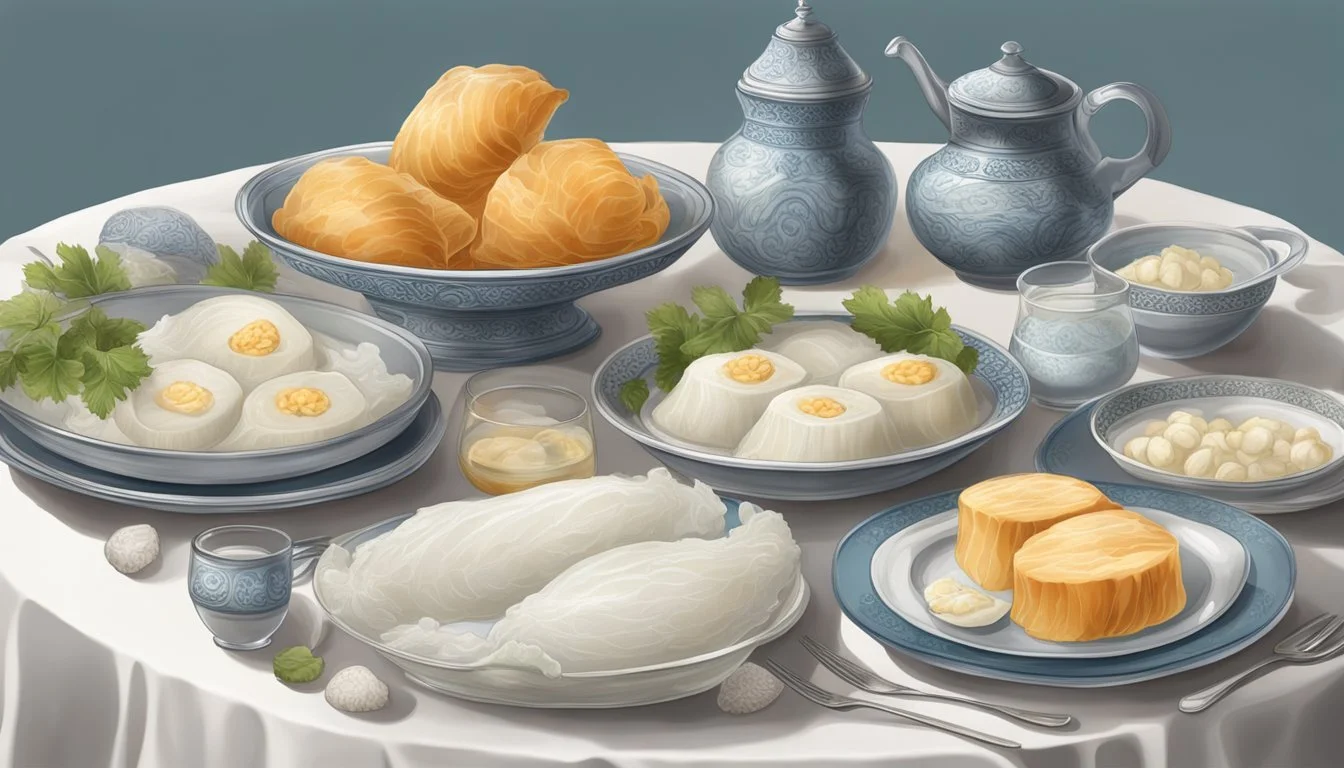Lutefisk The Gelatinous Norwegian Delicacy Made with Lye - A Culinary Adventure
Lutefisk is a traditional Norwegian delicacy with a long-standing heritage in Scandinavian cuisine. This gelatinous fish dish is made primarily from dried whitefish, often cod, which is then treated with lye in a method that dates back centuries. The result is a distinctive, somewhat jelly-like consistency which is quite unlike that of any other seafood preparation. Despite its texture and pungent aroma—a direct outcome of the lye treatment—lutefisk remains a celebrated part of Norwegian culinary tradition, particularly during the holiday season.
The preparation of lutefisk involves a meticulous process that transforms the dried fish into its final, edible form. Initially, the fish is soaked in cold water for several days and then submerged in a lye solution for an additional period. The lye, a caustic substance, breaks down the proteins in the fish, which results in the characteristic gelatinous texture. Subsequently, the fish is soaked in water again to remove the lye, a step that must be carefully managed to ensure the final product is safe to consume. Once the lye is fully rinsed out, lutefisk can be cooked, often by boiling or baking, and is typically served with accompaniments such as bacon, pea stew, or mustard sauce.
While lutefisk may polarize opinion, it is a symbol of Norwegian culture and history. Some view this dish with affection and nostalgia, recalling communal feasts and holiday gatherings. Others, including those unaccustomed to its unique flavor profile and texture, may find lutefisk to be an acquired taste. Regardless, it is an integral part of the Scandinavian festive gastronomy and continues to be a focal point of culinary discussion and intrigue for both its devoted fans and those encountering it for the first time.
Historical Origins
Lutefisk's historical journey is integral to understanding its place in Norwegian culture. Originating with the Vikings and spreading across the regions of Scandinavia, this fish dish secured its cultural significance as a traditional Christmas food.
Viking Roots
Vikings, often regarded as skilled seafarers and fishermen, are credited with the early creation of Lutefisk. The method used by the Vikings involved drying fish, likely cod, to preserve it for long voyages. It's believed that Viking fishermen inadvertently discovered that soaking the dried fish in lye could rehydrate and tenderize it, leading to the foundation of Lutefisk. Historical records, including those of Olaus Magnus, a Swedish writer in the 16th century, note the existence of this unique preservation method.
Geographical Spread
From its rudimentary inception, Lutefisk spread across the Scandinavian countries of Norway, Sweden, and Finland. These regions shared close cultural ties and had climates conducive to the drying of fish. As Scandinavians emigrated to other parts of the world, notably to the Midwest of the United States and places like Minnesota with substantial Nordic populations, they brought the tradition of Lutefisk with them. This allowed the dish to secure a foothold among Scandinavian communities outside of Europe.
Cultural Significance
Traditionally, Lutefisk has been closely associated with Christmas celebrations in Norway and other Scandinavian nations. The dish represents more than just a culinary preference; it's deeply embedded in the customs and practices of the festive season. Notably, in both Scandinavian countries and the Lutheran churches of the Midwest, Lutefisk dinners (What wine goes well with dinner?) have become a communal event signaling the start of the Christmas holidays. This annual tradition sustains the historical linkage between the Norwegian delicacy and its significance during Christmas, cementing its status as an enduring and cherished Christmas dish in both Scandinavian and Scandinavian-American cultures.
Ingredients and Preparation
This section outlines the traditional components and detailed steps needed to create lutefisk, providing a glimpse into its unique culinary journey, from rehydrated fish to a meal ready for serving.
Key Ingredients
Lutefisk is a dish that commonly uses aged whitefish, such as cod or ling. The fish is initially preserved through a drying process to create stockfish, which is then transformed into lutefisk via a rehydrating process using water and lye, a potent alkaline solution. The resulting gelatinous texture of lutefisk is balanced through careful neutralization of the pH levels.
Whitefish (cod, ling): dried to create stockfish
Lye: a crucial ingredient in lutefisk creation, sourced from birch ash
Water: for soaking and neutralizing the lye fish
Salt: for seasoning and creating salt deposits
Lutefisk Creation Process
The transformation of dried whitefish into lutefisk is a meticulous process that involves several steps. The dried whitefish is first soaked in cold water for several days, with the water changed daily. It is then soaked in an even stronger solution of water and lye. After the lye soak, the fish must be soaked in a fresh water sequence to remove excess lye, with water changes occurring over a period of days until the pH level is safe for consumption.
Soaking: Initial rehydration of stockfish in water
Treatment with lye: Introduces the necessary chemical reaction
Rinsing: Removes excess lye to achieve safe pH levels
Cooking: Final preparation of the fish before serving
Preparing Accompaniments
Serving lutefisk typically involves a set of traditional accompaniments that help to enhance its flavor and texture. These sides often include boiled potatoes, mashed peas, or mashed rutabaga. Additionally, fried bacon, melted butter, or white sauce add richness to the dish. Other accoutrements like flatbread or lefse can pair well for a more comprehensive meal experience.
Potatoes: Often boiled and served alongside or mashed
Bacon: Fried to add a salty and crispy texture contrast
Peas: Green peas are boiled for a side or mashed into a pea purée
Sauces: White sauce or melted butter commonly drizzled on top
Traditional Norwegian recipes may call for various approaches in preparing lutefisk, but the harmony of the accompaniments with the lye fish is universally acknowledged in contributing to a balanced dish.
Serving and Presentation
Lutefisk, known for its unique jelly-like consistency, is traditionally served with an array of side dishes that complement its distinct flavor and texture. Presentation plays a crucial role in enhancing the experience of enjoying this Norwegian delicacy.
Traditional Pairings
Lutefisk is usually accompanied by a variety of sides that balance its soft texture. The classic serving includes:
Boiled potatoes: A staple side that offers a neutral taste against the lye-soaked fish.
Mashed green peas: Adds color and a mild sweetness to the dish.
Melted butter: Often drizzled over the top to add richness.
White sauce or gravy: Provides moisture and enhances flavor.
Bacon: Small pieces of fried bacon contribute a crispy texture and savory note.
Lefse: A traditional Norwegian flatbread, serving as an optional wrap for the lutefisk.
Traditionally, the fish and its accompaniments are plated simply, allowing the lutefisk to remain the centerpiece of the meal.
Modern Variations
Chefs and home cooks have introduced new pairings to refresh this heritage dish. Modern takes on lutefisk might involve:
Mustard sauce: Some modern recipes substitute traditional white sauce with a mustard sauce for a piquant kick.
Bold spices: A light sprinkling of ground allspice or black pepper can elevate the flavor profile.
With the evolving culinary landscape, lutefisk presentations are adapting to contemporary tastes while respecting the essence of this longstanding tradition.
Health and Nutrition
When approaching the health and nutrition of lutefisk, one needs to consider both its nutritional content and any health considerations associated with its unique preparation.
Nutritional Information
Lutefisk is a low-fat, high-protein food. The process of making lutefisk does not significantly alter the protein content of the fish, preserving its nutritional value in terms of protein. Here is a breakdown of the typical nutritional content in a standard serving size:
Protein: A 6-ounce serving of lutefisk typically contains about 40 grams of protein, which is essential for muscle repair and growth.
Fat: Lutefisk is generally low in fat, with only a small amount present in a standard serving.
Calories: A serving of lutefisk usually contains approximately 220 calories, making it a moderate option in terms of energy provided.
Health Considerations
The unique aspect of lutefisk is its preparation with lye (sodium hydroxide), which is a high pH alkaline chemical. Health concerns may arise if the lye is not thoroughly washed out because it can cause chemical burns to the skin and tissues if handled improperly or consumed. It is crucial that lutefisk is prepared with care to ensure the complete conversion of lye to a benign state, making it safe for consumption.
pH Levels: The lye solution used to treat lutefisk has a high pH, but the fish is thoroughly soaked and rinsed afterwards to remove residual lye, bringing the pH to a safe level for consumption.
Handling and Cooking: Proper handling and cooking are important to ensure that any remaining lye is neutralized. Cooks must follow specific preparation methods to ensure the fish's safety and edibility.
Cultural Celebrations
Lutefisk holds a significant place in cultural events and is depicted in various aspects of popular culture, highlighting the tradition's importance among Norwegian communities, especially in the Midwest of the United States.
Festivals and Events
Minnesota, with its strong Scandinavian heritage, is a hub for lutefisk celebrations, especially in areas with a high density of Norwegian descent. The tradition is often centered around lutefisk dinners, social events typically held in Lutheran churches throughout the Midwest. These dinners, which can serve hundreds of people in a single event, showcase lutefisk's gelatinous texture and unique preparation method. Madison, Minnesota, known as the "Lutefisk Capital of the USA," even boasts an annual Lutefisk Eating Contest, emphasizing the dish's cultural significance.
Lutefisk Dinners: These events are a common feature in the Midwest, known for their community feel and celebration of heritage.
Madison, Minnesota: Hosts a noteworthy annual Lutefisk Eating Contest, drawing attention and participation from lutefisk enthusiasts.
Representation in Popular Culture
Lutefisk has been referenced in multiple popular culture instances, reinforcing its iconic status among Norwegian traditions. Eric Dregni, an author, has explored lutefisk's cultural impact in his works, bringing attention to this unique culinary tradition. Additionally, the influence of lutefisk on regional culture gave birth to Lou T. Fisk, a mascot character representing lutefisk, adding a humorous touch to the tradition's representation in the Midwest.
Eric Dregni: An author who has documented lutefisk in his publications, providing insights into its cultural context.
Lou T. Fisk: A caricature mascot that personifies the lutefisk tradition, adding a light-hearted element to its cultural celebrations.
Contemporary Availability
As lutefisk maintains its legacy within Scandinavian cuisine, its availability persists not just in Norway but extends to Scandinavian communities abroad, particularly in regions of the United States known for high Scandinavian ancestry such as Minnesota, Wisconsin, and the Pacific Northwest.
Restaurants and Retail
Restaurants across Scandinavia continue to keep lutefisk on the menu, showcasing traditional recipes. In Norway, it remains a festive favorite during the Christmas season. The dish has also found a place in Scandinavian restaurants and church events in the United States, especially in the Upper Midwest. Retail availability ranges from specialty Scandinavian shops to online stores, providing a convenient option for those looking to enjoy lutefisk at home. Freshness is key, and so lutefisk is often sold in fridge-friendly packages.
Locations where lutefisk is common:
Restaurants in Norway, Sweden, and Finland
Scandinavian eateries in the Upper Midwest, USA
Cultural events and festivals
Online retailers and specialty shops
Home Cooking Trends
In homes, lutefisk preparation styles vary with some adhering to traditional methods and others adapting with modern conveniences like the microwave oven. Still, the fundamental practice of rehydrating the dried fish in water and parboiling it wrapped in cheesecloth remains vital for achieving its characteristic texture. Alongside the continuance of this culinary tradition, there have been instances of utilizing aluminum foil in place of cheesecloth for ease. Cooking at home is seasonal, with a significant spike during the holiday season as families gather to honor their heritage.
Typical lutefisk preparation methods at home:
Soaking and rehydrating the dried fish
Parboiling the fish to achieve the jelly-like consistency
Use of aluminum foil as a modern alternative to cheesecloth
Related Foods and Influences
Lutefisk's lye-cured tradition echoes through Scandinavian cuisine and has found its way into cultural customs, such as the lutefisk dinners in the United States, particularly within the Midwest, where Scandinavian heritage runs deep.
Scandinavian Cuisine Influences
Lutefisk, a traditional dish from Norway, has its roots deeply embedded in Scandinavian cuisine. This gelatinous fish dish is most commonly made from stockfish, usually cod, but sometimes burbot or ling. Its preparation is similar to that of other Nordic preserved seafood dishes, emphasizing the importance of seafood in the diet of Norway, Sweden, Finland, and other Nordic countries. Another staple, lefse, a traditional Norwegian flatbread, often accompanies lutefisk, showcasing the typical pairing of fish with simple carbohydrates in Scandinavian diets.
Local Adaptations in the US
In the Midwest of the United States, lutefisk has become a symbol of Scandinavian heritage, especially among Norwegian, Swedish, and Finnish American communities. Adaptations of this European delicacy have surfaced, including lutefisk dinners that foster a sense of community and celebrate ethnic identity. While the traditional method of preparing lutefisk is preserved, it is often served with a variety of side dishes influenced by local American cuisine, integrating lutefisk into the broader culinary landscape. These gatherings reflect a respect for ancestral customs while allowing for regional influences to shape the experience.
Conservation and Sustainability
The section delves into the practices surrounding the iconic Norwegian lutefisk, focusing on the fishing of stockfish and the distinct preparation process. Both areas have direct implications on sustainability and conservation efforts.
Stockfish and Sustainable Fishing
Stockfish, the starting point of lutefisk, is traditionally made from cod, caught by Norwegian fishermen often depicted as hardy Viking descendants. These fishermen have historically used sustainable methods, ensuring that fish populations remain healthy. Modern stockfish production adheres to strict fishing quotas and regulations to prevent overfishing.
Key practices:
Selective fishing gear: Reduces bycatch of non-target species.
Fishing quotas: Ensures sustainable population levels.
Seasonal restrictions: Protect spawning fish, contributing to stock replenishment.
Stockfish is air-dried on large wooden drying racks, usually made of sustainable materials like birch. The birch racks, a traditional image associated with this process, allow for natural preservation without the use of chemicals, thus minimizing ecological footprint.
Environmental Impact of Lutefisk Preparation
Lutefisk preparation involves soaking stockfish in lye, which is obtained from birch ash. The lye treatment is critical, turning the stockfish into the gelatinous texture lutefisk is known for. However, the environmental concerns arise from the disposal of lye and the associated waste products.
Key concerns:
Proper disposal: The process necessitates careful handling of lye to avoid soil and water contamination.
Neutralization: Methods to neutralize lye before disposal are crucial in minimizing the environmental impact.
Waste management: The leftover ashes and waste water require appropriate treatment to ensure they do not harm the ecosystem.
In short, the production of lutefisk, from the harvesting of stockfish to the peculiar preparation involving lye, carries a responsibility to both marine life and the environment, which producers and consumers alike must acknowledge and act upon to ensure that this traditional delicacy can be enjoyed for generations to come, with minimal harm to the natural world.
Conclusion
Lutefisk is a traditional Norwegian dish that evokes strong reactions, from awe to skepticism, due to its unique preparation and texture. Made from whitefish cured in lye, it transforms into a gelatinous, quasi-translucent delicacy often served during the Christmas season.
Key Points about Lutefisk:
Texture: Its gelatinous consistency is unlike most seafood, offering a distinctive culinary experience.
Flavor: While some describe the taste as mildly fishy, others find it bland, necessitating the addition of bold condiments.
Preparation: The meticulous lye-curing process is followed by thorough rinsing to ensure safety when consumed.
Cultural Importance: Lutefisk holds historical significance in Norway, symbolizing tradition and festivity.
For many Norwegian families, lutefisk remains a cherished element of cultural heritage and holiday celebrations. Those unfamiliar with the dish may find its lye-based preparation method intriguing or even daunting. Given its acquired taste, lutefisk may not appeal to everyone, but it indisputably enriches Norway's gastronomic tapestry.
Despite divided opinions, lutefisk's presence on the holiday table continues to be a testament to Norway's enduring customs. It carries the flavors of history, community, and perseverance. Whether it is deemed delicious or peculiar, lutefisk's story is interwoven with Norwegian identity and will likely persist for generations to come.






